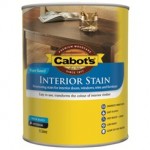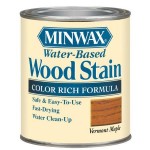Water Based Stains
Water based stains use a water based finish as the binder and replace most of the organic thinner with water. These stains will pollute less, less irritating to be around, and are easier to clean than oil or varnish stains. They are more suited for interior applications, as they do  not stand up to the elements like their oil base counterparts do.
not stand up to the elements like their oil base counterparts do.
Water-based stains are usually the best stain to use under water-based finishes because these finishes don’t bond well over oil or varnish stains unless you allow adequate drying time. The one down side to these stains is the fact they can raise the grain of the wood, and they dry fast. Ideally to avoid the raised grain, its best to raise the grain with plain water and sand it off before applying a water based stain.
To raise the grain first, wet the wood with a wet cloth. Let the wood dry overnight or at least for a few hours in a warm, dry room. Then sand off the roughness and apply the stain. To bury raised grain, simply apply the first coat of finish over the stain and raised grain, then sand smooth.
Overcoming fast drying is more difficult. You can add a slow evaporating solvent (usually propylene glycol) provided by some manufacturers, or you can add lacquer retarder. But  adding either reduces the color intensity of the stain and defeats the main purpose of using water-based products in the first place—to reduce exposure to solvents.
adding either reduces the color intensity of the stain and defeats the main purpose of using water-based products in the first place—to reduce exposure to solvents.
A better method is to divide your project into smaller parts and apply and wipe off the stain on each before going to the next. You can also have a second person follow you, quickly wiping off the excess.
The advantages of water based stains are:
- Dries quickly
- Keeps its color for a longer period of time
- Provides a richer hue of color
- No harmful fumes or odors, not flammable
- Breathable stain
- Easy Clean up
- Extreme mildew and mold resistance
To Apply water based stains follow the steps below.
- Make sure wood is sanded to preferred grit and that all oil, grease, dust and debris are removed.
- The key with water based stains is prepare for the raised grain from the water in
 the stain. Do prepare properly, soak down the wood with a wet lint free rag. Make sure every part of the wood gets nice and wet. Allow this to fully dry.
the stain. Do prepare properly, soak down the wood with a wet lint free rag. Make sure every part of the wood gets nice and wet. Allow this to fully dry. - The grain should have raised by now, so go ahead and sand it down with a 220 grit to return the surface to nice smooth consistency.
- Mix the stain with a stick to get all the settled pigment at the bottom mixed in with the rest of the solution
- Separate your project into smaller sections. This is because water based stain dries quicker than traditional oil based.
- Brush on the stain in the chosen section. Move quickly, so the stain does not have time to dry before the wiping stage. Do not let the stain sit on the wood for more than two minutes before wiping. Be sure to follow the grain.
- When wiping off the stain use long even strokes to even the stain out. Make sure your rag is lint free. Always follow the direction of the grain.
- If the desired coat is not achieved, reapply a second coat after 30 minutes of drying.
- Let the stain dry for 24 hours before applying a clear coat.